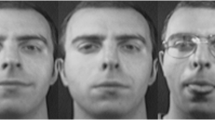Abstract
Kernel learning is widely used in many areas, and many methods are developed. As a famous kernel learning method, kernel principal component analysis (KPCA) endures two problems in the practical applications. One is that all training samples need to be stored for the computing the kernel matrix during kernel learning. Second is that the kernel and its parameter have the heavy influence on the performance of kernel learning. In order to solve the above problem, we present a novel kernel learning namely sparse data-dependent kernel principal component analysis through reducing the training samples with sparse learning-based least squares support vector machine and adaptive self-optimizing kernel structure according to the input training samples. Experimental results on UCI datasets, ORL and YALE face databases, and Wisconsin Breast Cancer database show that it is feasible to improve KPCA on saving consuming space and optimizing kernel structure.




Similar content being viewed by others
References
Lee J-S, Lin S-F (2010) A hierarchical face recognition scheme. Int J Innov Comput Inf Control 6(12):5439–5450
Wei X, Zhou C, Zhang Q (2010) ICA-based features fusion for face recognition. Int J Innov Comput Inf Control 6(10):4651–4661
Arora S, Bhattacharjee D, Nasipuri M, Basu DK, Kundu M (2011) Complementary features combined in a MLP-based system to recognize handwritten devnagari character. J Inf Hiding Multimed Signal Process 2(1):71–77
Krinidis S, Pitas I (2010) Statistical analysis of human facial expressions. J Inf Hiding Multimed Signal Process 1(3):241–260
Sayoud H, Ouamour S (2010) Speaker clustering of stereo audio documents based on sequential gathering process. J Inf Hiding Multimed Signal Process 1(4):344–360
Lin H-D, Peter Chiu Y-S (2010) RBF network and EPC method applied to automated process regulations for passive components dicing. Int J Innov Comput Inf Control 6(12):5077–5091
Tang H, Wu J, Lin Z, Lu M (2010) An enhanced AdaBoost algorithm with naive Bayesian text categorization based on a novel re-weighting strategy. Int J Innov Comput Inf Control 6(11):5299–5310
Yang J, Frangi AF, Yang J-Y, Zhang D, Jin Z (2005) KPCA plus LDA: a complete kernel fisher Discriminant framework for feature extraction and recognition. IEEE Trans Pattern Anal Mach Intell 27(2):230–244
Vapnik V (1995) The nature of statistical learning theory. Springer, New York
Lu J, Plataniotis KN, Venetsanopoulos AN (2003) Face recognition using kernel direct discriminant analysis algorithms. IEEE Trans Neural Netw 14(1):117–226
Baudat G, Anouar F (2000) Generalized discriminant analysis using a kernel approach. Neural Comput 12(10):2385–2404
Liang Z, Shi P (2005) Uncorrelated discriminant vectors using a kernel method. Pattern Recognit 38:307–310
MH Yang (2002) Kernel Eigenfaces vs. Kernel Fisherfaces: face recognition using kernel methods. In: Proceedings of the fifth IEEE international conference automatic face and gesture recognition, pp 215–220
Wang L, Chan KL, Xue P (2005) A criterion for optimizing kernel parameters in KBDA for image retrieval. IEEE Trans Syst Man Cybern B Cybern 35(3):556–562
Chen W-S, Yuen PC, Huang J, Dai D-Q (2005) Kernel machine-based one-parameter regularized fisher discriminant method for face recognition. IEEE Trans Syst Man Cybern B Cybern 35(4):658–669
Amari S, Wu S (1999) Improving support vector machine classifiers by modifying kernel functions. Neural Network 12(6):783–789
J-B Li, Pan J-S, Lu Z-M (2009) Kernel optimization-based discriminant analysis for face recognition. Neural Comput Appl 18(6):603–612
Samaria F, Harter A (1994) Parameterisation of a stochastic model for human face identification. In: Proceedings of 2nd IEEE workshop on applications of computer vision, Sarasota, FL
Belhumeur PN, Hespanha JP, Kriegman DJ (1997) Eigenfaces vs. Fisherfaces: recognition using class specific linear projection. IEEE Trans Pattern Anal Mach Intell 19(7):711–720
Wolberg WH, Street WN, Heisey DM, Mangasarian OL (1995) Computer-derived nuclear features distinguish malignant from benign breast cytology. Human Pathol 26:792–796
Acknowledgments
This work is supported by National Science Foundation of China under Grant No. 61001165, and Heilongjiang Provincial Natural Science Foundation of China (Grant No. QC2010066), and HIT Young Scholar Foundation of 985 Project.
Author information
Authors and Affiliations
Corresponding author
Rights and permissions
About this article
Cite this article
Li, JB., Gao, H. Sparse data-dependent kernel principal component analysis based on least squares support vector machine for feature extraction and recognition. Neural Comput & Applic 21, 1971–1980 (2012). https://doi.org/10.1007/s00521-011-0600-z
Received:
Accepted:
Published:
Issue Date:
DOI: https://doi.org/10.1007/s00521-011-0600-z




